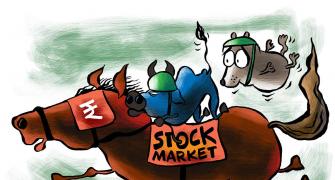Of the total revenues generated by the Indian studios, approximately 70 per cent comes from outsourced work.
While the domestic market is still very nascent, analysts predict there is tremendous growth opportunity for animated content in television and movies.
Over the next four years, the growth in the domestic demand for broadcast animated content on TV is projected to grow at a compounded annual growth rate (cagr) of 49.5 per cent, according to a Nasscom report.
For the same period, the market for fully animated movies in India is likely to match the offshore market, growing from its current size of Rs 65 crore (Rs 650 million) to Rs 340 crore (Rs 3.40 billion).
While the growth is evident, issues like funding, quality and skill sets are the challenges that the industry is grappling with.
"India has a large base of stories and lot of them are going into production. But funding is a huge issue. An average quality work project will cost anywhere between Rs 5-6 crore (Rs 50-60 million). But if you are looking at Hollywood quality work, it will be upwards of Rs 50-60 crore," says Tapaas Chakravarti, managing director and chief executive officer, DQ Entertainment.
DQ Entertainment recently announced its foray into Bollywood with the production of an action film and an animated TV series.
While revenues from the domestic market will be in the range of 7-8 per cent by 2009, Chakravarti is expecting a growth of 45 to 50 per cent during 2009-2011.
The company plans to produce an action film every year, starting from 2008 along with an animated TV series every 18 months.
Two major concepts for a full length feature film and animation in Indian content is also under development.
The industry realises that it cannot sustain purely on overseas work. Moreover, with forex fluctuations, these companies need to look at business models that can sustain growth.
Kanakasabapathy Pandyan, director (planning and strategy), Graphiti School of Animation agrees.
"Yes, the domestic market is certainly growing. But unlike the IT industry which has grown on the services model the animation industry cannot work like that. Rather, those who went in for this model are now complaining that their bottomlines are getting affected. Besides, scaling up is a huge issue. Apart form a few players who have about 2,000 employees, others manage with 200-300 people."
From day one Graphiti has focussed on creating intellectual property (IP)-based work. Pandayan believes that apart from entertainment, demand for animation will also spring from the medical and architectural verticals.
Toonz Animation, which worked on the animated Tenali Rama series and India's first successful animated feature film, Hanuman, is working on 20 projects in collaboration with Indian and international partners.
Jaya Kumar, CEP, Toonz Animation added, "If you look at any cartoon channel in India, there is very little Indian content. Moreover, there is a dearth of content as these programmes are being repeated at least three to five times a year. The Indian industry will take its time to grow, especially for the TV, as there is no mature revenue model. A lot is still being tested."
Toonz has signed up with Percept Picture for the production of Hanuman 2, which is due to release on December 20, 2007. Demand for animated content is also rising as a majority of kids and parents, who view this content, reside in tier II and III cities. <hr>
Looney Toons
Domestic entertainment animation industry is expected to touch Rs 1000 cr by 2011
Fully animated film segment should grow to Rs 340 crore in the next four years
TV/broadcast animated content is growing at 49.5% CAGR
There are 500 studios in India







